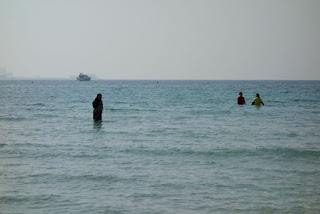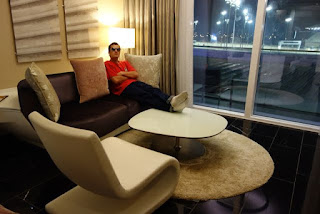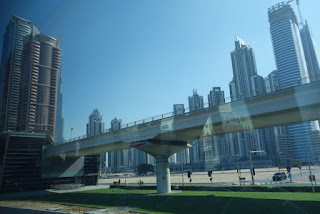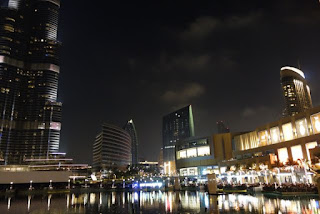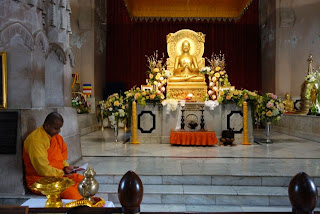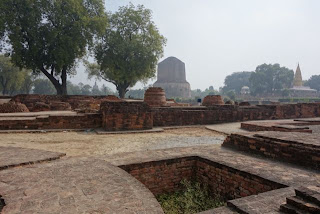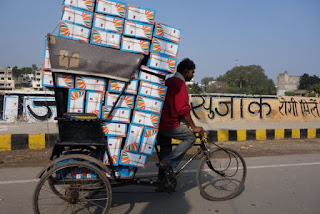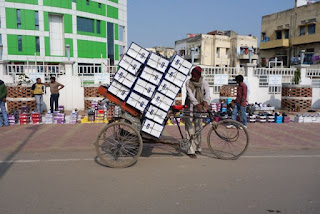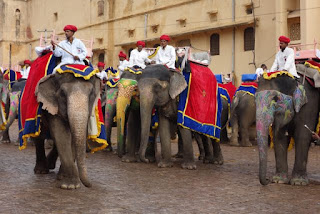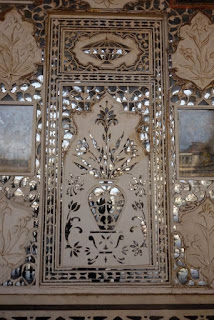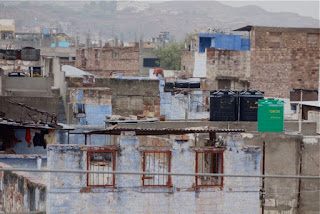Wednesday, January 16th – Jodpur City to Manvar Desert Camp
After the usual hotel breakfast and fueled with several cups of extremely strong coffee, we meet our guide and driver for our morning tour of Jodpur. Our driver maneuvers through the chaos of the old city and uphill towards the Mehrangarh Fort.
 |
| View of Mehrangarh Fort |
 |
| Jaswant Thada |
Our first stop is at the Jaswant Thada, a palatial memorial and garden honoring Rajasthan royalty. It is an active cremation site with views of the Fort above and beyond and our guide explains that for the Hindu, cremation returns the body to the 5 elements, air, sky, water, earth and fire.
 |
| Jaswant Thada Ghats |
 |
| Royal Cenotaph Cremation Site |
Our guide waits outside while John and I remove our shoes and climb the steep stone stairway to the memorial. The cold of the marble floors is chilling but the visual warmth of the translucent light streaming through ornate pierced stone and windows is lovely.
 |
| Jaswant Thada guard reading in the morning sun |
 |
| Pierced marble window detail |
 |
| Detail of the doors |
The road ascends higher to the Mehrangarth Fort, a massive stone fortress that sits sentry above Jodpur. Parts of this 15th century fort are the current residence of Rajasthan royalty but visitors are allowed to tour much of the fort and the museum exhibitions. We ascend to the battlement by elevator and take in the views of Jodpur City, a jumble of blue block cube houses, clinging to the hillside below and beyond.
 |
| Jodhpur City view from Mehrangarh Fort |
 |
| Exterior detail of Mehrangarh Fort |
The buildings of the city below all have flat topped roofs and our guide tells us that the rooftops are used for sleeping during the hot summer months. I am struck by how neat and clean these spaces appear, unlike in Egyptian cities where the roof tops views I recollect were cluttered with rubble, garbage and innumerable satellite dishes.
 |
| Jodhpur – The blue city. |
We spend the next two hours touring the public rooms, courtyards and exhibits within the fortress. The architecture is a mixture of Hindu and Muslim influences with scalloped windows and intricately carved shutters and pierced stone window coverings.
 |
| Woman sweeping – Mehrangarh Fort |
 |
| Interior courtyard – Mehrangarh Fort |
As in all the palaces and forts there are rooms for the men with open windows and balconies overlooking the courtyard below and sequestered chambers for the wives and concubines.
The windows in the woman’s quarters are ornately pierced of stone so that they may see out but no one can see in and the woman’s quarters are lack balconies.
 |
| Guard leaning out ornately carved windows |
 |
| Stained glass reflections |
Various rooms house exhibits of palanquins, baby cradles, miniature paintings, textiles and weapons. John and I focus on the details of the metalwork and sculptural accents at the ends of the palanquins and knives.
 |
| Peacock Palanquin |
 |
| Elephant sculpture on knife |
As remarkable as the miniature paintings are, we are beginning to tire of these and circulate the painting galleries quickly. Our guide is knowledgeable and patient but notably surprised and perhaps a bit disappointed with our quick exit of the gift shop.
 |
| Peacocks crowning a babys cradle |
 |
| Gilded and mosaiced ceiling detail |
Although we enjoyed last night’s visit to the market we are not sated and we ask to walk down from the fort into the old town so that we may experience the city in the daylight.
 |
| John and our guide walking the ancient rode into the city |
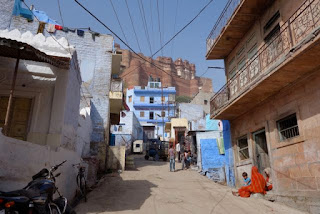 |
| View up the street to the Mehrangarth Fort above |
The ancient street, winding down from the fortress is constructed of age polished blocks of uneven stone. I carefully pick my way down the street lest I slip or turn an ankle. John, true to form, bounds 5 feet up onto the ancient 2’ wide, stone wall that follows the curve of the road and drops down many feet to the town below. I cannot see above and below this high wall but both our guide and I caution and beseech John to come down. A few twists and turns later when the wall deteriorates to an unmanageable jumble of stones, John jumps down and walks beside me on the ancient fortress road.
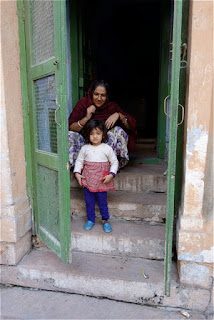 |
| Woman with child |
 |
| Jodhpur – The blue city |
The road winds between the jumble of blue block buildings that we had viewed from above and it is fascinating to peek into ancient doorways and to imagine the lives lived within. Wide eye children stare curiously at us and half veiled women watch us suspiciously.
 |
| Men passing time |
 |
| Man sitting |
Men squat at the side of the road and young men gather in groups, arms around each other and cell phones in hand. The men and boys are not afraid to ask where we are from and to shake our hands.
 |
| Women seen through abandoned Tut-tut |
 |
| School boys going home in a Tut-tut |
The main market square of Jodhpur City is bustling but unfortunately, we have only a few brief minutes to take in the colorful chaos before heading to lunch and driving to Manvar Desert Camp.
 |
| Sardar Market Square – Jodhpur |
 |
| Locksmith merchant |
 |
| Mother and child |
 |
| Street child |
After lunch at On The Rocks, a touristy garden restaurant, we get back in the car for a 2 ½ hour drive to Manvar Desert Camp. The road show is always interesting and we pass two camels pulling carts piled high with black plastic water cisterns. They trot down the highway, sharing road space with horn honking, “Goods Trucks” and the usual mixture of motorcycles, livestock and humanity. The loads are twice the height of the camels and I wonder how often the large cisterns break free and roll down the highway, creating even more havoc on the road way.
 |
| Camel pulling cart with plastic water tanks |
 |
| Goods Truck hauling uncovered quarry rock |
 |
| Colorful “Goods Trucks” |
I touch type and look out the window as city turns to countryside and the countryside morphs to scrub desert. The day is sunny and bright and the desert landscape is dotted with thorny bushes and cactus. Interspersed in the desert landscape are occasional patches of green where irrigation turns the desert into farmland.
 |
| Manvar Desert Resort |
The Manvar Resort is like any of the 5 star hotels, an enclave of lush gardens and courtyards and a pool with pale tourists reclining on poolside lounges. John and I are at the resort for just long enough to drink a welcome hibiscus tea and register our passports and credit card before transferring into jeep that will take us to the tented camp.
 |
| Jeep tracks |
Our driver and a Manvar Camp host, ride in front and John and I ride, without seatbelts, in the open back. Initially, we backtrack down the paved road before turning onto a dirt road for a 1 ½ hour desert tour. The jeep slides down some very steep and sandy embankments and we see many antelope and gazelles grazing in the scrub desert terrain. The largest of the antelopes is an impressive and stocky nilgai.
 |
| Sliding down the embankment – Antelope below |
 |
| The large Nilgai Antelope |
Our driver does a good job at giving us a memorable jeep experience but as a geologists’ daughter, this jeep safari is tame. I have read about this desert area and am not expecting sand dunes but when we come to a series of small dunes, our driver stops. We walk barefoot in the sand and John does back flips off the inclines of the sand dunes. I think that I am taking a movie of his acrobatics, but unfortunately, I use the wrong camera setting throughout the trip and return home with only still shots.
 |
| John does back flips on the sand dunes |
Our “tour” is to include a visit to a desert village. We stop at a family compound and are ushered inside the walled courtyard. I feel that we are intruding but we have been told that it is the visits from the tourists that help to sustain these families and our guide explains that they alternate visiting different family compounds so that no one group is overly disturbed or gets all the tips.
 |
| Family Compound |
 |
| Inside the courtyard of a family compound |
The hard packed dirt courtyard is immaculately swept and there are three thatched round adobe huts built along the inside perimeter of the walls. We peek inside the largest and I am pleasantly surprised to see the tidy and efficient arrangement. Colorful clothing is draped over a long pole that crosses the room and mattresses are piled to one side and neatly covered. Three suitcases are tucked into a recessed alcove and a few pictures are arranged on a shelf. Another of the huts is outfitted as the kitchen and black iron cooking pots sit on an extinguished fire pit and dry goods are stored in a recessed alcove.
 |
| The sleeping room |
 |
| The cooking room |
The small children watch us curiously but the mother is standoffish and keeps her face covered with a veil. No one speaks and two young women, possibly John’s age, stare solemnly at him. Before hand, our guide suggested that we give the family a small amount of money so I hand the mother 20 rupees and John pulls pens and candy from his backpack to give to the children.
Our guide asks us if we would like to visit a blacksmiths shop and my interest peaks. The blacksmiths compound, along a rutted dirt road, is built on a small rise. We stoop to enter a round adobe thatched hut where an elderly man crouches on the dirt floor beside a wood fire. His wife (presumably) squats against the wall spinning a bicycle tire connected to a belt that spins a smaller wheel that is rigged to blow air into the coals to heat them to a glowing red.
 |
| Blacksmith |
The man is forging a steel rod into a tool and alternates between heating the rod in the coals and pounding the glowing red metal on a rock to shape it appropriately. A young boy, silhouetted dark against the bright afternoon light, watches from the doorway. John squats beside the man to see more closely as the man repeatedly heats and forges a crude iron tool. He then proceeds to put tobacco and coals from the fire into a short ceramic cone shaped pipe.
 |
| John and Blacksmith with pipe |
He tips his head to one side and keeping the pipe vertical inhales several times and passes the pipe to John. John tries to duplicate this maneuver but when he bends his head to get below the mouthpiece, the pipe tips at a 45 degree angle. The glowing coals threaten to fall onto John’s shoes and the man’s bare feet and our guide steps quickly forward to prevent disaster and John manages an awkward inhalation or two. The pipe is offered to me but I decline. In the interim, a basket of shiny brass pipes has mysteriously appeared on the bench beside me and I presume that the family is hoping that we will purchase one but strangely, no mention is made of this. As we leave, I tip the man 20 rupees.
Beautiful children carrying baby goats along the road.
 |
| Boy and girl carrying baby goats |
 |
| Girl with baby goat |
It is late afternoon when we arrive at our tented camp for the night. We are in tent number one, on the uphill edge of this gently sloping desert camp and closest to the main dining tent. A precise semi circle of over 30 permanent canvass tents, defines the perimeter of the camp.
 |
| Manvar tented camp |
We are delighted to be here although both John and I were hoping for a more authentic and rustic setting. Inside the large, open fronted dining tent, waiters are setting the tables and readying a flat topped wooden wagon into a bar on the sand beyond. A semicircle of cushions with low tables curves around a large circular cement stage where we will presumably sit and watch the evening dance and music performance. Our tent is lovely with twin tapestry covered beds and a private bathroom off the back. The fading afternoon light casts a warm glow through the orange and yellow tapestry walls at the heads of our beds.
 |
| Tent interior – Manvar tented camp |
The temperature is dropping and John turns on a small space heater which warms the interior quickly but I question the safety of this and wonder how quickly we will be able to unzip the tent in the event of a fire.
 |
| Playing cards together |
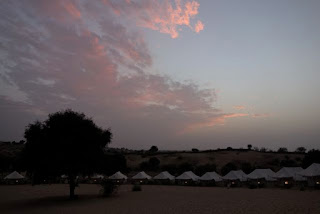 |
| A desert sunset at Manvar Tented Camp |
The jovial French tour-group, begin to choose stage side seating in anticipation of the evening performance and John and I take cushioned seats and wait.
 |
| Stage side seating in the sand |
I am not a fan of these touristy music and dance performances but I have alternately enjoyed and suffered through many on my travels. Tonight’s performance is the worst. There is no sound system and no stage lighting and the music is barely audible in the vastness of open night air. What we can hear is tinny and amateurish so the lack of amplification may have been a blessing. Waiters circulate with trays of appetizers and John and I talk and nibble. Although we are disappointed with the quality of the performance, we enjoy ourselves nevertheless.
 |
| Twirling dancers |
John obliges when a young male performer approaches him, nearly pleading that he come onstage and dance the grand finale with them. A dozen drunken French tourists, John and a few gypsy dancers form a conga line and twirl awkwardly in the light of the small flickering fires.
 |
| Dancing French tourists, Gypsy dancers and John |
 |
| Conga line at Manvar Desert Camp |
The performance over, the dancers set a narrow lipped vase at the edge of the stage but make no mention of tips or the purpose of the jug. I expect the French tourists to take the lead and deposit tip money into it but when no one does, John and I slink off and up to the dining tent without leaving a tip.
My conversational French needs much practice so John and I sit alone at a table for 4. The dining tent is lit only by lanterns and candles and a dozen covered and heated casserole warmers line the buffet table brimming with the expected assortment of curries, rice, vegetables, lamb and chicken and naan. The food is passable but not memorable and with another full day accomplished, we trudge off towards tent number one, just below the dining tent and fall asleep to the pleasant chatter and laughter of the French tourists.
















